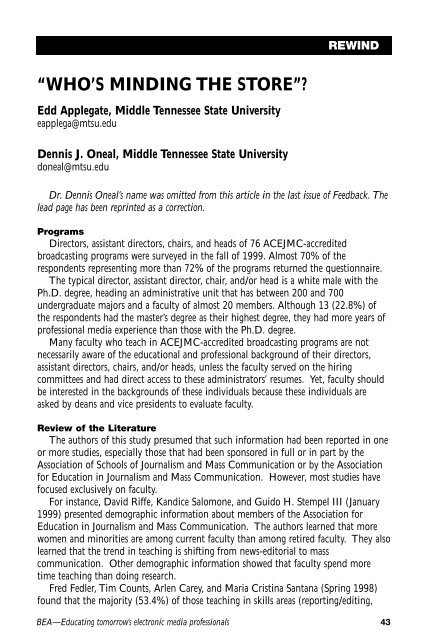Feedback May 2002 (Vol 43 No 2)
Feedback May 2002 (Vol. 43, No. 2) - Broadcast Education ...
Feedback May 2002 (Vol. 43, No. 2) - Broadcast Education ...
- No tags were found...
Create successful ePaper yourself
Turn your PDF publications into a flip-book with our unique Google optimized e-Paper software.
REWIND“WHO’S MINDING THE STORE”?Edd Applegate, Middle Tennessee State Universityeapplega@mtsu.eduDennis J. Oneal, Middle Tennessee State Universitydoneal@mtsu.eduDr. Dennis Oneal’s name was omitted from this article in the last issue of <strong>Feedback</strong>. Thelead page has been reprinted as a correction.ProgramsDirectors, assistant directors, chairs, and heads of 76 ACEJMC-accreditedbroadcasting programs were surveyed in the fall of 1999. Almost 70% of therespondents representing more than 72% of the programs returned the questionnaire.The typical director, assistant director, chair, and/or head is a white male with thePh.D. degree, heading an administrative unit that has between 200 and 700undergraduate majors and a faculty of almost 20 members. Although 13 (22.8%) ofthe respondents had the master’s degree as their highest degree, they had more years ofprofessional media experience than those with the Ph.D. degree.Many faculty who teach in ACEJMC-accredited broadcasting programs are notnecessarily aware of the educational and professional background of their directors,assistant directors, chairs, and/or heads, unless the faculty served on the hiringcommittees and had direct access to these administrators’ resumes. Yet, faculty shouldbe interested in the backgrounds of these individuals because these individuals areasked by deans and vice presidents to evaluate faculty.Review of the LiteratureThe authors of this study presumed that such information had been reported in oneor more studies, especially those that had been sponsored in full or in part by theAssociation of Schools of Journalism and Mass Communication or by the Associationfor Education in Journalism and Mass Communication. However, most studies havefocused exclusively on faculty.For instance, David Riffe, Kandice Salomone, and Guido H. Stempel III (January1999) presented demographic information about members of the Association forEducation in Journalism and Mass Communication. The authors learned that morewomen and minorities are among current faculty than among retired faculty. They alsolearned that the trend in teaching is shifting from news-editorial to masscommunication. Other demographic information showed that faculty spend moretime teaching than doing research.Fred Fedler, Tim Counts, Arlen Carey, and Maria Cristina Santana (Spring 1998)found that the majority (53.4%) of those teaching in skills areas (reporting/editing,BEA—Educating tomorrow’s electronic media professionals <strong>43</strong>
















